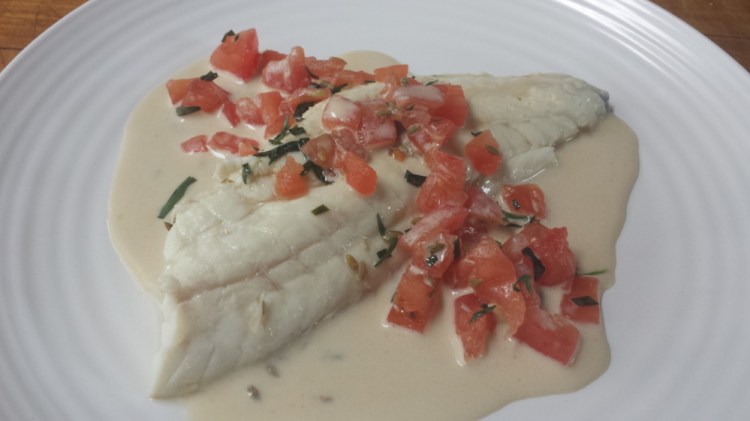A newish fish is coming to town soon, and there are three very good reasons you might want to eat it for dinner.
The fish is black sea bass.
The reasons for consuming it are: The white flesh is sweet and mild, and its bones make great stock (see recipe below); the fish prey on shrimp, crab and lobster, all of which are tightly regulated Gulf of Maine fisheries; and, because black sea bass is popular with high-end chefs along the Eastern Seaboard, selling it could be a boon for struggling local fishermen.
Historically, black sea bass have been found in the highest concentrations between Cape Cod, Massachusetts, and Cape Hatteras, North Carolina, where they are sought after by both commercial and recreational fishermen and are subject to size restrictions and tight quotas. Fishery management plans instituted in Massachusetts, Rhode Island and the mid-Atlantic states in 2002, after the stock was declared to be overfished, have allowed their numbers to return to sustainable levels.
Until about five years ago, very few hearty (or very hungry) black sea bass would venture into the chillier waters of the Gulf of Maine. But evidence exists of both fast-warming Maine waters and more black sea bass ending up as bycatch in Maine lobster traps.
After finding these out-of-place spiky-finned fish in the traps she helped her lobsterman father pull out of the water along the midcoast the past few summers, Northeastern University graduate student Marissa McMahan is hoping to quantify just how many black sea bass are summering in Maine. In a crowd-sourcing video pitch to potential donors to fund her dissertation field work, McMahan explains that tracking the abundance and distribution shifts of black sea bass is a first step to understanding the ecological impacts and economic implications of their presence here.
Meanwhile, the Department of Marine Resources is formulating rules for landing black sea bass in Maine, effectively creating a new commercial fishery.
Mike Alfiero, co-owner of Harbor Fish Market in Portland, normally sources the black sea bass he sells in his shop from Rhode Island. Earlier in the year, he had a steady supply, but the state’s fishermen hit a quarterly quota that has curtailed his cache until May 1. At that time, fisherman there will be able to reel in a second portion of their allowable catch before the fishery is closed in August for spawning. In the meantime, Alfiero, who prefers to roast his black sea bass whole, with crispy skin, is sourcing them from Connecticut. But who knows? Maybe one day he’ll be sourcing them from the Gulf of Maine.
POACHED BLACK SEA BASS WITH FENNEL, CUCUMBER, TOMATOES AND TARRAGON
Recovering chef – as he calls himself – and sustainable seafood advocate Barton Seaver of Freeport explains that since the yield of edible flesh on black sea bass is only 40 percent of the fish’s weight, the way to cook it with as little waste as possible is to poach it in a stock made from its own bones. Since black sea bass has the distinction of being the very best of all fish for stock preparation – yielding a delicately flavored broth with a perfect, gelatinous consistency – this is not a hardship. “While its subtlety may be lost in dishes with huge flavors and multiple components such as a bouillabaisse, it makes an incredibly good … reduced sauce,” Seaver says. This is his recipe. He suggests serving the fish with rice pilaf with almonds and herbs.
Serves 4
Two (2½-3-pound) black sea bass, cleaned, filleted, eyes and gills removed
6 tablespoons butter
1 fennel bulb, thinly sliced
1 shallot, peeled and sliced
2 cups dry white wine
Kosher salt
1 teaspoon fennel seeds
1 cup cucumber peels
1 cup chopped fresh tomato
1 tablespoon torn tarragon leaves
Set the fish fillets aside. Rinse the fish bones to remove any blood.
In a large oval pot stockpot, melt 3 tablespoons butter over medium heat. Lay the fish bones in the pot. Scatter the fennel and shallot around the bones. Allow the vegetables to soften slightly but not color, 3 to 4 minutes. Add the wine, 4 cups water and a large pinch of salt. Allow the stock to simmer undisturbed for 20 minutes. Remove the pan from the heat and cool its contents. Gently pour off the cooled stock into a large skillet. (If you don’t have time to cool the stock, you can pour it off warm, but the sauce won’t be as clear.) Discard the bones.
Add the fennel seeds and cucumber peels to the stock. Bring the liquid to a simmer, reduce the heat, attach a thermometer to the pan and adjust the heat further to hold the poaching liquid at about 165 degrees. Gently slide the fish fillets into the liquid and poach until just cooked through, about 4 minutes. Remove the fish and hold at room temperature.
Raise the heat to medium high, use a slotted spoon to remove the cucumber peels, and reduce the liquid by two-thirds. Remove the reduced sauce from the heat, whisk in the remaining 3 tablespoons butter. Stir in the tomatoes and tarragon. Pour the sauce over the fillets and serve.
Christine Burns Rudalevige is a food writer, recipe developer and tester, and cooking teacher in Brunswick. Contact her at cburns1227@gmail.com.
Copy the Story LinkSend questions/comments to the editors.



Success. Please wait for the page to reload. If the page does not reload within 5 seconds, please refresh the page.
Enter your email and password to access comments.
Hi, to comment on stories you must . This profile is in addition to your subscription and website login.
Already have a commenting profile? .
Invalid username/password.
Please check your email to confirm and complete your registration.
Only subscribers are eligible to post comments. Please subscribe or login first for digital access. Here’s why.
Use the form below to reset your password. When you've submitted your account email, we will send an email with a reset code.